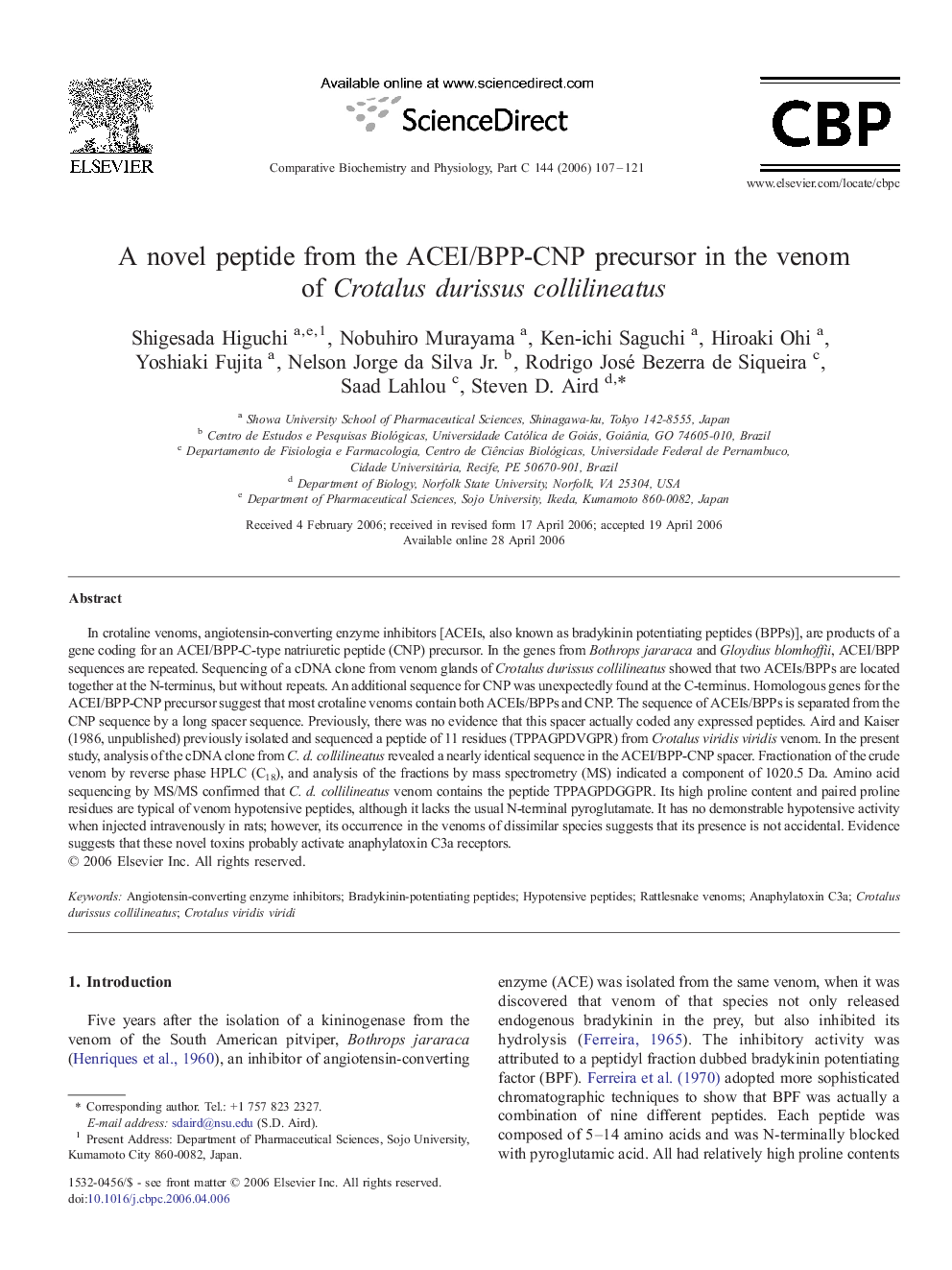| کد مقاله | کد نشریه | سال انتشار | مقاله انگلیسی | نسخه تمام متن |
|---|---|---|---|---|
| 1978188 | 1061531 | 2006 | 15 صفحه PDF | دانلود رایگان |
عنوان انگلیسی مقاله ISI
A novel peptide from the ACEI/BPP-CNP precursor in the venom of Crotalus durissus collilineatus
دانلود مقاله + سفارش ترجمه
دانلود مقاله ISI انگلیسی
رایگان برای ایرانیان
کلمات کلیدی
موضوعات مرتبط
علوم زیستی و بیوفناوری
بیوشیمی، ژنتیک و زیست شناسی مولکولی
زیست شیمی
پیش نمایش صفحه اول مقاله

چکیده انگلیسی
In crotaline venoms, angiotensin-converting enzyme inhibitors [ACEIs, also known as bradykinin potentiating peptides (BPPs)], are products of a gene coding for an ACEI/BPP-C-type natriuretic peptide (CNP) precursor. In the genes from Bothrops jararaca and Gloydius blomhoffii, ACEI/BPP sequences are repeated. Sequencing of a cDNA clone from venom glands of Crotalus durissus collilineatus showed that two ACEIs/BPPs are located together at the N-terminus, but without repeats. An additional sequence for CNP was unexpectedly found at the C-terminus. Homologous genes for the ACEI/BPP-CNP precursor suggest that most crotaline venoms contain both ACEIs/BPPs and CNP. The sequence of ACEIs/BPPs is separated from the CNP sequence by a long spacer sequence. Previously, there was no evidence that this spacer actually coded any expressed peptides. Aird and Kaiser (1986, unpublished) previously isolated and sequenced a peptide of 11 residues (TPPAGPDVGPR) from Crotalus viridis viridis venom. In the present study, analysis of the cDNA clone from C. d. collilineatus revealed a nearly identical sequence in the ACEI/BPP-CNP spacer. Fractionation of the crude venom by reverse phase HPLC (C18), and analysis of the fractions by mass spectrometry (MS) indicated a component of 1020.5Â Da. Amino acid sequencing by MS/MS confirmed that C. d. collilineatus venom contains the peptide TPPAGPDGGPR. Its high proline content and paired proline residues are typical of venom hypotensive peptides, although it lacks the usual N-terminal pyroglutamate. It has no demonstrable hypotensive activity when injected intravenously in rats; however, its occurrence in the venoms of dissimilar species suggests that its presence is not accidental. Evidence suggests that these novel toxins probably activate anaphylatoxin C3a receptors.
ناشر
Database: Elsevier - ScienceDirect (ساینس دایرکت)
Journal: Comparative Biochemistry and Physiology Part C: Toxicology & Pharmacology - Volume 144, Issue 2, October 2006, Pages 107-121
Journal: Comparative Biochemistry and Physiology Part C: Toxicology & Pharmacology - Volume 144, Issue 2, October 2006, Pages 107-121
نویسندگان
Shigesada Higuchi, Nobuhiro Murayama, Ken-ichi Saguchi, Hiroaki Ohi, Yoshiaki Fujita, Nelson Jorge Jr., Rodrigo José Bezerra de Siqueira, Saad Lahlou, Steven D. Aird,